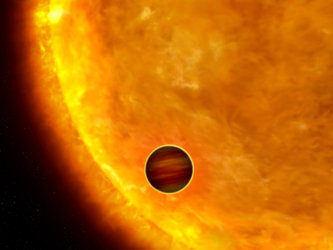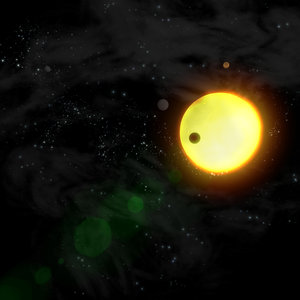Exoplanet hunt update
Two new exoplanets and an unknown celestial object are the latest findings of the COROT mission. These discoveries mean that the mission has now found a total of four new exoplanets.
These results were presented this week at the IAU symposium 253 in Massachusetts, USA.
COROT has now been operating for 510 days, and the mission started observations of its sixth star field at the beginning of May this year. During this observation phase, which will last 5 months, the spacecraft will simultaneously observe 12 000 stars.
The two new planets are gas giants of the hot Jupiter type, which orbit very close to their parent star and tend to have extensive atmospheres because heat from the nearby star gives them energy to expand.
Scientists suspect that with the detection of COROT-exo-3b, they might just have discovered the missing link between stars and planets.
In addition, an oddity dubbed ‘COROT-exo-3b’ has raised particular interest among astronomers. It appears to be something between a brown dwarf, a sub-stellar object without nuclear fusion at its core but with some stellar characteristics, and a planet. Its radius is too small for it to be a super-planet.
If it is a star, it would be among the smallest ever detected. Follow-up observations from the ground have pinned it at 20 Jupiter massses. This makes it twice as dense as the metal Platinum.
Scientists suspect that with the detection of COROT-exo-3b, they might just have discovered the missing link between stars and planets.
COROT has also detected extremely faint signals that, if confirmed, could indicate the existence of another exoplanet, as small as 1.7 times Earth’s radius.
COROT has also detected extremely faint signals that, if confirmed, could indicate the existence of another exoplanet, as small as 1.7 times Earth’s radius.
This is an encouraging sign in the delicate and difficult search for small, rocky exoplanets that COROT has been designed for.
Note for editors:
COROT was launched atop the Soyuz from the Baikonour cosmodrome in Kazakhstan on 27 December 2006. Settled in its almost-circular polar orbit ranging between 895 and 906 km above Earth's surface, the spacecraft was first powered on 2 January 2007 and started its science observations on 3 February of the same year.
COROT is a CNES project with ESA participation. The other major partners in this mission are Austria, Belgium, Brazil, Germany and Spain.
For more information:
Malcolm Fridlund, ESA COROT Project Scientist
Malcolm.Fridlund @ esa.int















 Germany
Germany
 Austria
Austria
 Belgium
Belgium
 Denmark
Denmark
 Spain
Spain
 Estonia
Estonia
 Finland
Finland
 France
France
 Greece
Greece
 Hungary
Hungary
 Ireland
Ireland
 Italy
Italy
 Luxembourg
Luxembourg
 Norway
Norway
 The Netherlands
The Netherlands
 Poland
Poland
 Portugal
Portugal
 Czechia
Czechia
 Romania
Romania
 United Kingdom
United Kingdom
 Slovenia
Slovenia
 Sweden
Sweden
 Switzerland
Switzerland






































